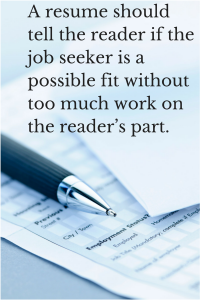INSIDE THE 
NEWS + ADVICE
FAQs About Your Resume
 At a recent ClearedJobs.Net Resume Review session, job seekers asked lots of questions. But, what they boil down to is this: What will get my resume read? Translated this question really boils down to this one: What makes a resume effective?
At a recent ClearedJobs.Net Resume Review session, job seekers asked lots of questions. But, what they boil down to is this: What will get my resume read? Translated this question really boils down to this one: What makes a resume effective?
A resume is effective if it is relevant to the job applied for. To do this a resume needs to focus on the applied-for-job’s requirements and show instances of the job seeker utilizing the required skills and knowledge with results, i.e., Accomplishment Statements. If it gains enough attention from the recruiter or hiring manager to get them to want to learn more about you, and results in an e-mail or call, the resume has done its job.
However, saying that and doing that are two entirely different things. Here are some of the job seekers’ questions that drill down to revealing HOW to produce a resume that gets read.
Question: How do I make my resume pop?
This was the most frequently asked question at the recent Cleared Job Fair, so if you’ve been wondering the same thing you have lots of company. What job seekers were really asking was how to make their resumes stand out, get noticed, get read, and get call backs.
Answer: Show results.
Showing the results of your efforts in the jobs you’ve held is a major differentiation between resumes that read like job descriptions and those that pop. Showing outcomes of duties you performed and tasks you did in your previous – and current if you are employed – positions distinguishes your resume from the masses.
Showing outcomes to your tasks becomes an attention grabber. Showing outcomes of your efforts is a way to put your money where your mouth is. In interviews employers hear continuously from candidates who say they have the skills, knowledge, abilities, aptitude and attitudes that the employer is looking for. Showing outcomes or results offers substantiation to your claims of competency. It offers proof that a) you are what you say you are, and b) you can do what you claim because you have done it before and, “Here are my results.”
So, the answer is to make your resume more than a laundry list of duties you performed. Offering proof via showing the results of those duties, called Accomplishment Statements, is a way to not only get your resume to pop but to get it read.
Question: I’ve spoken with 10 different people and gotten 10 different answers about what my resume should look like. Why?
Answer: There’s no one way to write a resume.
Writing an effective, attention-getting resume is an art, not a science. Just as there is no one way to perform any art, there is no singular way to write a resume.
However, and it’s a big however, there are tried and true techniques or guidelines for producing a resume that tells the story of your career in a succinct, orderly, and persuasive enough way to get recruiters to read it, pass it along to hiring managers, and gain interviews. These techniques include:
Using an easy-to-read format that includes the following standard components: your contact information and security clearance, career summary or key skills, professional experience, education & training, and professional associations
A chronological approach that makes it easy for the recruiter to gauge if you meet the job requirements
Career or Professional Summary that includes key skills and makes the reader want to know more. If this doesn’t grab their attention, they won’t read on further down the page.
Using Accomplishment Statements that show not only what you did but what you achieved. This also subtly shows cause and effect thinking – a desirable attribute.
Giving the reader – your customer – what they want. An example: Education generally goes on the second page of an experienced job seeker’s resume. However if a cleared recruiter at a job fair mentions they like to see Education up front, in your follow-up thank you letter and additional attached copy of their resume move Education to the front page. It should be positioned after the Career Summary and before Professional Experience. Pay attention to:
1. Any requested change or preference expressed by a recruiter.
2. Any request made by the employer in the advertisement for the position.
Remember, your cleared resume is nothing more than your sales brochure, designed to sell the prospect on the idea that you could be the one. If you show enough of what they are looking for, they may be sufficiently interested to decide they want to learn more about you in an interview.
Question: Should my Career Summary be a paragraph or a list of bullet points? What should it include?
Answer: Either a paragraph or a bulleted list works – your choice. The Career Summary is a version of your elevator speech.
The Career Summary is that paragraph or bulleted list that appears on the top half of the front page of your resume, right underneath your header. Please remember to include your clearance in your header.
The Career Summary provides the reader with an Overview of you as a candidate. It should tell the reader:
- What you do, i.e. your profession: “I am a _____________.”
- The area of your expertise: Your track record
- Skills and strengths – And what you achieve because of them
- Unique attributes (degrees, certifications, experience, languages) relevant to the job or profession you are pursuing
The key to producing a Career or Professional Summary that employers, recruiters, and network contacts will want to read is to make it:
- Relevant to the type of job you are seeking, as well as
- Relevant to the employer’s interests and requirements
Question: How do I show 20 (25, 30, 40) years of experience on 2 pages?
Answer: You don’t unless the job description specifically requires that many years of experience…which very few cleared jobs do require.
I’m beginning to sound like a broken record here, I know, but what you show is experience that is relevant to the type of job you seek, the type of industry & employer you have targeted, and the requirements of the job description.
- Select from your own comprehensive “laundry list” of duties those that are relevant to each position you apply for.
- Be sure you have shown results for each of these duties, i.e., Accomplishment Statements.
- Tweak your Career Summary to overview those selected Accomplishment Statements.
- Be sure that you have demonstrated the requested years of experience in the job description.
A Bonus Question: What do you do with those early jobs that relate to the position you are applying for but go back more than 10 or 15 years and the job description doesn’t require that many years’ experience?
Answer: Include a category with these early and relevant jobs called “Other Relevant Experience.” List jobs with title, and relevant Accomplishment Statements. Leave off dates.
Remember when you are looking for a job you are in sales – selling the most important product or service you will ever sell…you! You are selling your abilities as potential solutions to employers’ problems and needs. By identifying what makes you desirable as a potential candidate, and showing this on your resume, you up the odds that your resume will be read and you’ll get a call back inviting you to tell the hiring prospect more about how you might be just who they are looking for.
Best of luck with your search.
 Nancy Gober is a career strategist who has helped thousands of job seekers find employment. She’s also been a popular resume reviewer at our Cleared Job Fairs. You may reach Nancy via email at [email protected]. Follow Nancy on Twitter @AfterJobClub.
Nancy Gober is a career strategist who has helped thousands of job seekers find employment. She’s also been a popular resume reviewer at our Cleared Job Fairs. You may reach Nancy via email at [email protected]. Follow Nancy on Twitter @AfterJobClub.

